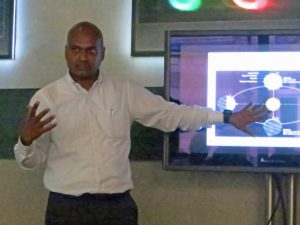May 23, 2017
“Amazing Astronomical Alignments” – History of Astronomy Group Meeting – 23rd May 2017
Bobby Manoo
Report by: Mike Dryland
Bobby Manoo gave an excellent talk about “amazing astronomical alignments”. Bobby was inspired during a visit to Egypt when he saw the pyramids and especially the temple at Abu Simbel.
He began with a short introduction to the equinoxes and solstices, and a look at the ‘analemma’ pattern traced out by the position of the Sun when seen at the same time each day. He turned to man’s fascination with the stars going back to earliest known times – the patterns in the stars and the daily and annual movements of the Sun, Moon, and planets have always been a source of awe, an inspiration for religious beliefs, legends, and architecture, and a treasure-trove of practical calendar knowledge. Bobby set out to show how the repeating patterns of movements in the heavens have been embodied in monumental buildings by countless generations. He reviewed an impressive series of monumental sites covering many millennia and many cultures across the world:
The Maya – the pyramid of Kukulkan, Chichen Itza, (Mexico) c. 9th century CE. At the equinoxes a face of the pyramid casts a long shadow of a feathered serpent on the northwest ballustrade.
The Inca – Machu Picchu, Cusco (Peru) c. 15th century CE. A ritual stone, the Iti Watana (“Hitching post”) is said to be carved to point directly at the Sun on the winter solstice.
Peublo culture — Chaco Canyon, New Mexico (USA) c. 12th century CE. Many buildings aligned to the solar, lunar, and cardinal points, and a carving, the “Sun Dagger”, is said to mark the solstices, equinoxes, and lunar standstills.
Neolithic England – Stonehenge (Wiltshire, UK) c. 20th – 30th centuries BCE. Monument developed over several phases and said to embody multiple alignments to the solstices, equinoxes, and lunar standstills.
Central European Neolithic — Goseck Circle (Saxony-Anhalt, Germany) c. 49th century BCE. Palisaded henge circle (reconstructed) with three entrances said to be aligned to cardinal north, and sunrise and sunset at winter solstice.
India – Konark Sun Temple c. 13th century CE, embodies sophisticated sundials.
Buddhist India – Ajanta Caves c. 7th century CE, large series of caves with several entrances artificially tunnelled to align with the solstices.
India – Jantar Mantar, New Delhi c. 18th century CE, sophisticated observatory complex with many stone-built observing platforms arranged for accurate measurement of astronomical movements, and large 70-ft sundial.
Ancient Egypt – Karnak, Precinct of Amun Re c. 21st century BCE. Huge complex aligned to winter solstice sunrise.
Ancient Egypt – pyramids of Giza c. 25th century BCE. Famous site said to embody many sophisticated astronomical alignments, and to be laid-out in imitation of the Orion star pattern. Also the Sphinx, said to be aligned east-west so the Sphinx faces the rising Sun on the equinox.
Ancient Egypt – Abu Simbel temples c. 13th century BCE. Huge and very impressive site containing a complex of statues said to be illuminated by the rising Sun only on the dates of the Pharaoh Ramesses II’s birthday and coronation.
Bobby’s talk was most entertaining and enjoyable. It triggered some energetic debate about the age of the pyramids and the exact nature of some of the alignments described. Bobby demonstrated comprehensively how mankind has been fascinated by the heavens since history began, and has sought to use the patterns of movement in the sky in the design of his most important monuments. The purpose of the monuments mainly remains a subject of heated discussion! Many thanks to Bobby for a great evening.
Posted under: Flamsteed, History of Astronomy, Meeting Report





You must be logged in to post a comment.